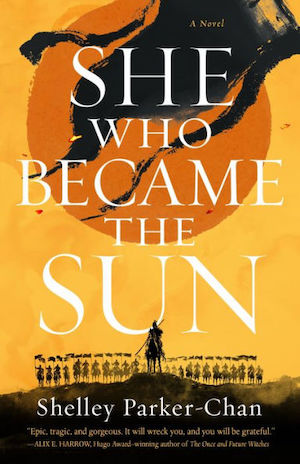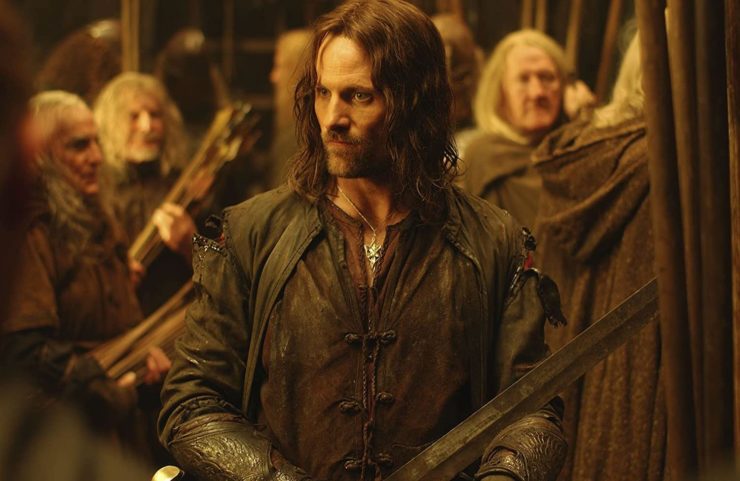Middle-earth was born in the trenches of the First World War. It was there that J.R.R. Tolkien began writing the stories that eventually became The Silmarillion, and it was there where Tolkien experienced “the loss and the silence” that informs his entire mythic cycle. Tolkien famously served in the horrific Battle of the Somme, in which 300,000 men died for six miles of broken, ruined territory. The losses in the war for Tolkien were personal. “By 1918, all but one of my close friends were dead,” he once wrote.
Despite that, Tolkien’s writings are never explicitly anti-war. After all, most of the battles he depicts are explicitly between good and evil. But like the Old English, Norse, and Germanic tales that so inspired him, Tolkien’s view of war is complex, one that both glorifies the bravery and camaraderie of warriors in battle, and ruminates on the death and loss that inevitably follows. Much as a hero’s quest, like Frodo’s, forever changes a man, so war inevitably reshapes the countries that fight in it. There’s no going back. Every war means the end of a world.
Not for nothing does Tolkien insert his own version of the Old English poem The Wanderer into The Two Towers, turning it into a lament of the Rohirrim (whose names and culture are based on the Old English):
Where now the horse and the rider? Where is the horn that was blowing?
They have passed like rain on the mountain, like a wind in the meadow
The days have gone down in the West behind the hills into shadow.
Peter Jackson wisely includes this poem in his adaptation of The Two Towers, in what I must say is the single best scene in the entire trilogy. On the eve of battle, Rohan’s King Théoden (a wonderful Bernard Hill) recites the poem as a servant armors him. In the background, through a door blazing with heavenly light, soldiers pass like shades— “walking shadows” as Shakespeare put it in Macbeth, another work that heavily inspired Towers (though in a different way). Interspersed are shots of Saruman’s Uruk-hai army marching to Helm’s Deep to “destroy the world of Men.” War is coming, and the lives of Men are as brief as the flicker of shadows in a doorway.
After the breaking of the Fellowship at the end of the first movie, Frodo and Sam plod towards Mordor, soon guided by the treacherous Gollum, only to wind up in the hands of Faramir’s desperate Gondorrim guerillas. Aragorn, Legolas, and Gimli pursue the Uruk-hai across the plains of Rohan and are drawn, Seven Samurai-style, into that country’s internal and external conflict against Saruman. Gandalf returns from the dead with a new color and mission: to urge Théoden to meet Saruman’s armies head-on in battle. Merry and Pippin, meanwhile, escape their captors and try to rouse the tree-herding Ents to war.
Buy the Book


She Who Became the Sun
While The Fellowship of the Ring is a fantasy quest, The Two Towers is a war movie. There was, of course, plenty of fighting in Fellowship, and there are plenty of fantastical elements in Towers. But Towers is a darker, grimmer movie, more concerned with what war does to people, and peoples, than its predecessor. No more dragon-shaped fireworks, no more wizards fighting fire-demons over seemingly bottomless pits, no more Elven cities in the trees. We’re in the world of Men now, in the muck of battle.
It’s even in the landscape—even before Frodo, Sam, and Gollum are ambushed by Faramir’s soldiers, they wander through the Dead Marshes, a place inspired by Tolkien’s experiences at the Somme. It’s a land literally ruined and haunted by the War of the Last Alliance shown at the beginning of the first film. That war was, of course, entirely good and just, as Elves and Men allied to defeat the Dark Lord Sauron. But even that war, with all its righteousness and victory, left behind a landscape that is still shattered and infested by wraiths millennia later. The trauma of war never fully goes away, and it still has the power to drag you down into the darkness.
It’s in the characters, too. The movie’s breakout figure is Gollum, played brilliantly by a mo-capped Andy Serkis, who more or less invented an entirely new form of acting with his performance. Serkis and the CGI team that brought Gollum to life perfectly capture the corrupted hobbit’s bewildering mix of innocence, danger, and pathos. Ralph Bakshi’s Gollum was only half-realized, and the Rankin-Bass version serves mostly as nightmare-fuel for children, but Jackson smartly sees Gollum as the key to the entire story. His big blue eyes mirror Elijah Wood’s. He’s the Dead Marshes in hobbit-form: a broken and haunted vision of the fate that awaits Frodo if he gives in to the corruption of the One Ring. And Frodo knows it. His attachment to Gollum makes perfect sense: if Gollum can be saved, and be brought back from his pathetic state, then so can Frodo. There’s still hope.
The Frodo, Sam, and Gollum trio, and their character dynamics, serves as the heart of the movie. Gollum’s a mirror of Sam, too, with his eagerness to please “Master,” which arouses both Sam’s suspicions and jealousy. Frodo and Sam are both right about Gollum, and both wrong, which makes the tension between the three work so well, from their initial fight, to “po-ta-toes,” to Gollum’s eventual turn back to villainy at the end. And it’s what makes Gollum’s arc so tragic. He really did begin to turn himself around, until his rough-handling at the hands of Faramir’s soldiers at the Forbidden Pool, and his belief that Frodo betrayed him. Not all evil comes from evil rings or dark lords: sometimes it comes from basically good people doing what they think is right, and having everything go wrong anyway.
What works less well is Jackson’s depiction of Faramir, captain of Gondor. The movie rightly sets up the reveal that Faramir is Boromir’s brother as an “oh shit” moment for Frodo, but after that it doesn’t know what to do with the character. Moving the action to Osgiliath, the war’s frontline, isn’t a bad decision—it’s a more dynamic setting and gives the Frodo storyline a better visual parallel with the stories in Rohan and Fangorn. But the resolution, with Faramir letting Frodo go after witnessing him almost hand the Ring over to the Nazgûl, makes no sense. It’s a shame, too, because in the book Faramir is the key to understanding Tolkien’s view of war. “I do not love the bright sword for its sharpness, nor the arrow for its swiftness, nor the warrior for his glory. I love only that which they defend,” he tells Frodo.
The Faramir plot reveals Jackson’s weakness as a storyteller, which is that he doesn’t trust the audience to sit still for very long. You see this with the warg scene, as well, as the people of Edoras flee to Helm’s Deep and are ambushed by wolf-riding Orcs. But rather than exciting the audience, it’s a slog, because there’s no real tension. The warg attack is isolated from the train of civilians. At no point do they seem threatened. It doesn’t help that the otherwise good CGI falters a bit here, with the size of the wargs against the grassy hills never quite looking natural. Jackson clearly knows the scene doesn’t work, because rather than letting it exist on its own as a piece of the story, it ends with a cliffhanger that is the reddest of herrings. There’s no surprise or fear in Aragorn’s fall. We know he’ll be back: the third movie is titled The Return of the King. It’s all false tension.
Or take the Entmoot. We simply haven’t spent enough time with the Ents for their reluctance to fight, and Merry’s bitter rejoinder, to mean much. In the books, the Entmoot is a moving scene, where the last of an ancient and endangered species decide to march to war for the good of the world. It’s one of deliberate sacrifice. There’s a bit of that when they finally do march in the movie, mostly thanks to Howard Shore’s stirring music, but it’s undercut by how they got there. Pippin snookers Treebeard into dropping them off by Isengard, with an appeal that even Treebeard flatly says makes no sense. Somehow Pippin, not Treebeard himself, knew that Saruman had burned a patch of the forest. As with the Osgiliath scene, Jackson undercuts the tension rather than raising it, putting the characters in weird quandaries that then must be resolved quickly and somewhat absurdly. In other words: he’s hasty.
And yet, all that being said, Jackson is still a great director of immense talent, and I present as evidence: The Battle of Helm’s Deep. What in the books is a fairly brief skirmish is transformed into a landmark of cinema. Battle scenes have been part of movies since the earliest days, but even after a century of these epic moments, you can’t make a list of greatest battle scenes and not include Helm’s Deep. It’s the measurement against which all medieval and fantasy battles, especially sieges, must be judged. Game of Thrones explicitly used it as their model for the Battle of Winterfell in the final season.
There’s the Wanderer scene as set-up. Gandalf’s sunlit, nearly vertical cavalry charge down the hill at the end. And at the beginning, the almost unbearable build-up of tension with the rhythm of the rain falling, clanking against metal armor, lightning flashes, and the Uruk-hai roaring and stamping their spears—tension cut in a moment that is somehow both hilarious and dreadful, as a Rohirric soldier accidentally releases an arrow too early and fells an Uruk. Then come the ladders, the Uruks clinging like spiders as they scale the walls. And the Olympic Torch Orc, running into the Deeping Wall’s small culvert to blast the wall, and himself, to kingdom come, with Saruman’s gunpowder bomb. There in a single apocalyptic moment is Tolkien’s worldview—the old world is passing away, like rain on the mountain. Even a wizard must use industrial science to wage war in this new era. What chance does Magic stand against the Machine?
That’s a question Tolkien himself probably asked, in some way or another, in the trenches. His answer, it seems, lay in his imagination, conjuring a magical world of Elves and dragons in order to both escape, and to understand, the death and destruction around him. Jackson reflects this in Sam’s monologue in Osgiliath about “the stories that really matter,” which he juxtaposes with scenes of fighting at Helm’s Deep, and the Ents’ assault on Isengard.
The movie then ends somewhat abruptly, which makes the warg attack and Osgiliath errand all the more frustrating since that time could have been spent on wrapping up the Saruman storyline (which is given especially short and unsatisfying shrift in the theatrical version). Instead, we get Gandalf and company mounting the softest lit hill in all of Middle-earth, and somehow glimpsing the mountains of Mordor in the distance. And while I don’t mind Shelob being pushed to the third film, her absence means Frodo and Sam are more or less where we left them at the end of the first movie, still plodding towards the Land of Shadow, happy to be in each other’s company.
But despite the missteps in adaptation, The Two Towers is probably Jackson’s strongest Middle-earth movie. It revolutionized cinema with Serkis’ mo-capped Gollum and the Battle of Helm’s Deep, and powerfully brought Tolkien’s themes to the forefront. It’s a modern depiction of war and loss that even a Rider of the Mark, or an Old English bard, could appreciate.
Austin Gilkeson has written for Tin House, McSweeney’s, Vulture, Foreign Policy, The Toast, and other publications. He lives just outside Chicago with his wife and son.










